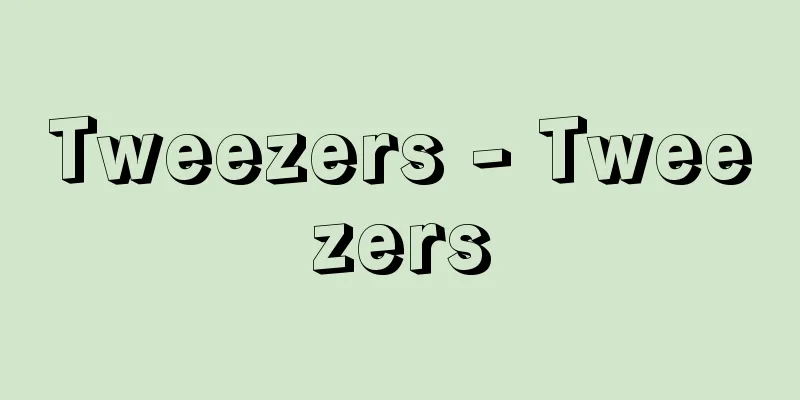Tweezers - Tweezers

|
Kabuki play. Historical piece. One act. Collaboration between Tsuuchi Hanjuro, Yasuda Abun, and Nakata Mansuke. This is an independent piece from the third act of "Narukami Fudo Kitayamazakura," which was first performed by Ichikawa Danjuro II at the Sadoshimaza Theater in Osaka in January 1742 (Kanpo 2). It has been selected as one of the "18 major kabuki plays" along with "Narukami" and "Fudo," both of which were derived from the same work. Nishiki, the daughter of the Ono family, falls ill with a strange disease that causes her hair to stand on end, and her marriage to her fiance, Bunya no Toyohide, is postponed. Toyohide's vassal Kumedera Danjo comes as a messenger to demand payment, but when the tweezers he used to pluck his beard stand up of their own accord, he discovers that a villainous member of the evil elder retainer Yatsurugi Genba's gang, who is plotting to embezzle the family fortune, is using a magnet to attract the princess's hairpin from above the ceiling, and he kills Genba to put an end to the commotion. The story incorporates scientific knowledge of magnets, which were rare in the Edo period, and is unique in its way of solving mysteries in a pseudo-detective novel style. The portrayal of Danjo, who is resourceful, versatile, and charming, is also interesting. The story had been discontinued since the end of the Edo period, but was revived in 1909 (Meiji 42) by Ichikawa Sadanji II in the script for Oka Kitaro, and became popular in modern times. The overall performance, including the various mie (poses) based on nishiki-e (colored woodblock prints), continues to be well-received today. [Toshiaki Matsui] Source: Shogakukan Encyclopedia Nipponica About Encyclopedia Nipponica Information | Legend |
|
歌舞伎(かぶき)劇。時代物。1幕。津打半十郎、安田蛙文(あぶん)、中田万助合作。1742年(寛保2)1月、大坂・佐渡島(さどしま)座で2世市川団十郎らにより初演された『雷神不動北山桜(なるかみふどうきたやまざくら)』の三幕目「小野館(おののやかた)」が独立したもの。同作から出た『鳴神』『不動』とともに「歌舞伎十八番」に選ばれている。小野家の息女錦(にしき)の前は頭髪が逆立つ奇病にかかり、許嫁(いいなずけ)文屋豊秀(ぶんやのとよひで)への輿入(こしい)れも延期。豊秀の家臣粂寺弾正(くめでらだんじょう)は催促の使者にきて、自分がひげを抜くために使った毛抜がひとりでに立ったことから、御家横領をねらう悪家老八剣玄蕃(やつるぎげんば)一味の曲者(くせもの)が天井裏から磁石で姫の櫛笄(くしこうがい)を引き付けているのを見破り、玄蕃を斬(き)って騒動を収める。江戸時代には珍しい磁石という科学知識を取り入れ、推理小説もどきに謎(なぞ)を解く趣向が異色。知略縦横で愛嬌(あいきょう)に富む弾正の描き方もおもしろい。幕末以来中絶していたのを、1909年(明治42)岡鬼太郎(おにたろう)の台本で2世市川左団次が復活し現代に流行した。錦絵(にしきえ)を参考にした各種の見得(みえ)をはじめ、全般の演出が今日も好評を得ている。 [松井俊諭] 出典 小学館 日本大百科全書(ニッポニカ)日本大百科全書(ニッポニカ)について 情報 | 凡例 |
Recommend
Advance loan - Zenshakukin
It refers to money advanced by an employer to a w...
Buccinum tenuissimum
…[Tadashige Nabe]. . … *Some of the terminology t...
Erica carnea (English spelling)
… [Kei Yamazaki]. … *Some of the terminology that...
Mitake (Yamaguchi)
…616m above sea level. Also called Odake, it is p...
Giacosa - Giuseppe Giacosa
Italian playwright. Born into a noble bourgeois f...
Ichi-sagari - Ichi-sagari
The name of the shamisen tuning. The first string ...
Heterocera
… Most moths are nocturnal, so many of them have ...
Papadopoulos, G.
...In the general elections of November 1963 and ...
Teucrium japonicum Houtt.
A perennial plant of the Lamiaceae family (illustr...
Lead poisoning - Endoku
〘 noun 〙 Poison contained in lead. Poisoning cause...
Get a bargain
Index. A transliteration of the English word "...
Te Deum (English spelling) [Latin]
This hymn begins with the words "Te Deum laud...
Farmland - of
This refers to land used for cultivation (Article...
Chutaro Kikuchi
...Takeuchi's "Gigaiten," Takamura&...
Katowice
The central city of the Upper Silesian industrial ...








![Toyama [city] - Toyama](/upload/images/67cc5bca1a844.webp)
